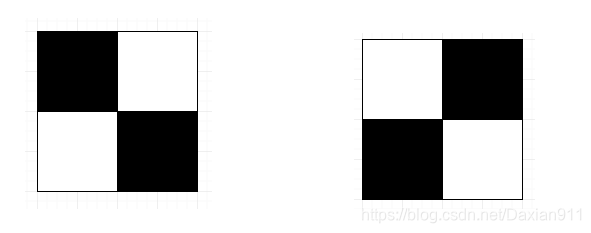You are given a grid, consisting of 22 rows and nn columns. Each cell of this grid should be colored either black or white.
Two cells are considered neighbours if they have a common border and share the same color. Two cells AA and BB belong to the same component if they are neighbours, or if there is a neighbour of AA that belongs to the same component with BB.
Let's call some bicoloring beautiful if it has exactly kk components.
Count the number of beautiful bicolorings. The number can be big enough, so print the answer modulo 998244353998244353.
Input
The only line contains two integers nn and kk (1≤n≤10001≤n≤1000, 1≤k≤2n1≤k≤2n) — the number of columns in a grid and the number of components required.
Output
Print a single integer — the number of beautiful bicolorings modulo 998244353998244353.
Examples
Input
3 4Output
12Input
4 1Output
2Input
1 2Output
2
Note
One of possible bicolorings in sample 11:
题意:给你一个2行n列的矩阵,每个格子可以染黑白两种颜色,问染成恰好k个连通域有几种方法,结果最后%998244353
设一个dp[i][j][k]
表示到第i列组成j个连通域第i列为k种状态时的方法数,,k=0表示第i列的颜色相同,k=1表示第i列的颜色不同
这样转移方程就好写了

上面四种情况是:dp[i][j][0]+=dp[i-1][j][1]*2;

这两种情况是:dp[i][j][0]+=dp[i-1][j][0];

这两种情况是:dp[i][j][0]+=dp[i-1][j-1][0];

这四种情况是:dp[i][j][1]+=dp[i-1][j-1][0]*2;

这两种是dp[i][j][1]+=dp[i-1][j-2][1];

这两种是:dp[i][j][1]+=dp[i-1][j][1];
详见代码:
#include <iostream>
#include <cstdio>
#include <cstring>
#include <cmath>
#include <algorithm>
#include <queue>
#include <map>
#include <stack>
#define pb push_back
#define INF 0x3f3f3f3f
using namespace std;
const int maxn=1e5+5;
typedef long long ll;
const ll mod=998244353;
ll dp[1005][2005][2],n,m;
int main()
{
scanf("%lld%lld",&n,&m);
memset(dp,0,sizeof(dp));
dp[1][1][0]=2;
dp[1][2][1]=2;
for(int i=2;i<=n;i++)
for(int j=1;j<=m;j++) {
dp[i][j][0]=(dp[i][j][0]+2*dp[i-1][j][1]+dp[i-1][j][0]+dp[i-1][j-1][0])%mod;
dp[i][j][1]=(dp[i][j][1]+dp[i-1][j-1][0]*2+dp[i-1][j][1]+dp[i-1][j-2][1])%mod;
}
printf("%lld\n",(dp[n][m][0]+dp[n][m][1])%mod);
return 0;
}




 京公网安备 11010502036488号
京公网安备 11010502036488号